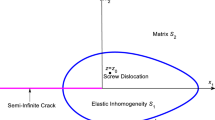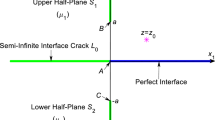Abstract
A comparison of elastic interaction of a dislocation and a crack for four bonding conditions of the crack plane was made. Four cases of single crystalline material, sliding grain boundary, perfectly bonded interface, and sliding interface were considered. The stress intensity factors arising from edge and screw dislocations and their image forces for the above four cases were compared. The stress intensity factor at a crack tip along the perfectly bonded interface arising from screw dislocation can be obtained from that in a single crystalline material if the shear modulus in the single crystalline material is replaced by the harmonic mean of both shear moduli in the bimaterial. The stress intensity factor at a crack tip along the sliding interface arising from edge dislocation in the bimaterial can be obtained from that along the sliding grain boundary in the single material if the μ/(1−ν) in the single material is substituted by the harmonic mean of μ/(1− ν) in the bimaterial where μ and ν are the shear modulus and Poisson's ratio, respectively. The solutions of screw dislocation near a crack along the sliding grain boundary and sliding interface are the same as that of screw dislocation and its mirror image. Generally, the effect of edge dislocation for perfectly bonded interface on the crack propagation is more pronounced than that for the sliding interface. The effect of edge dislocation on the crack propagation is mixed mode for the cases of perfectly bonded interface and single crystalline material, but mode I fracture for the cases of sliding interface and sliding grain boundary. All curves of Fx versus distance r from the dislocation at interface to the right-hand crack tip are similar to one another regardless of dislocation source for both sliding interface and perfectly bonded interface. The level of Fx for m=0 is larger than that for m=−1.
Similar content being viewed by others
References
Chen, B.–T., Hu, C.T. and Lee, S. (1998). Edge Dislocation Near a Cracked Sliding Interface(to be published).
Chuang, T.–J. (1982). A diffusive crack–growth model for creep fracture. Journal of the American Ceramic Society 65, 93–103.
Chuang, T.–J. and Rice, J.R. (1973). The shape of intergranular creep cracks growing by surface diffusion. Acta Metallurgica 21, 1625–1628.
Chuang, T.–J., Chu, J.L. and Lee, L. (1992). Asymmetric tip morphology of creep microcracks growing along bimaterial interfaces. Acta Metallurgica et Materialia 40, 2683–2691.
Chuang, T.–J., Chu, J.L. and Lee, L. (1996). Diffusive crack growth at a bimaterial interface. Transaction of the ASME, Journal of Applied Mechanics 63, 796–803.
Lakshmanan, V. and Li, J.C.M. (1988). Edge dislocation emitted along inclined planes from a mode I crack. Materials Science and Engineering A 104, 95–104.
Lee, S. (1994). General solution of screw dislocations near an interfacial crack. Materials Science and Engineering A 176, 335–240.
Lin, K.M., Hu, C.T. and Lee, S. (1987). Comparison of the effects of dislocations around internal and surface cracks on fracture. Materials Science and Engineering 95, 167–174.
Majumdar, B.S. and Burns, S.J. (1983). A Griffith crack shielded by a dislocation pile–up. International Journal of Fracture 21, 229–240.
Muskhelishvili, N.J. (1977). Some Basic Problems of the Mathematical Theory of Elasticity, 4th ed., Noordhoff, Leyden.
Peach, M.O. and Koehler, J.S. (1950). The forces exerted on dislocations and the stress fields produced by them. Physical Review 80, 436–439.
Suo, Z. (1989). Singularities interacting with interfaces and cracks. International Journal of Solids and Structures 25, 1133–1142.
Wang, S.D. and Lee, S. (1990). An analysis of the elastic interaction between an edge dislocation and an internal crack. Materials Science and Engineering A 130, 1–10.
Wang, S.D., Ouyang, H. and Lee, S. (1994). Screw dislocations near an interfacial cross crack. Physica status solidi A 144, 59–67.
Zhang, T.–Y. and Li, J.C.M. (1991a). Image forces and shielding effects of an edge dislocation near a finite length crack. Acta Metallurgica et Materialia 39, 2739–2744.
Zhang, T.–Y. and Li, J.C.M. (1991b). Image forces and shielding effects of a screw dislocation near a finite length crack. Materials Science and Engineering A 142, 35–39.
Zhang, T.–Y. and Li, J.C.M. (1992). Interaction of an edge dislocation with an interfacial crack. Journal of Applied Physics 72, 2215–2226.
Zhang, T.–Y. and Lee, S. (1993). Stress intensity factors of interfacial crack. Engineering Fracture Mechanics 44, 539–544.
Author information
Authors and Affiliations
Rights and permissions
About this article
Cite this article
Chen, BT., Hu, C. & Lee, S. Comparison of elastic interaction of a dislocation and a crack for four bonding conditions of the crack plane. International Journal of Fracture 91, 149–164 (1998). https://doi.org/10.1023/A:1007533914501
Issue Date:
DOI: https://doi.org/10.1023/A:1007533914501




